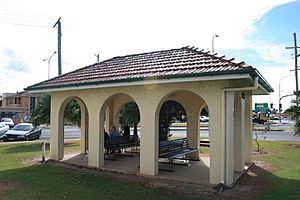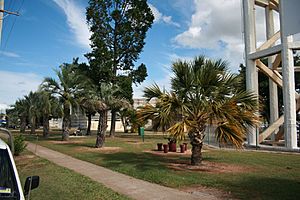Bundaberg War Nurses Memorial facts for kids
Quick facts for kids Bundaberg War Nurses Memorial |
|
|---|---|

Bundaberg War Nurses Memorial, 2009
|
|
| Location | Bourbong Street, Bundaberg West, Bundaberg, Bundaberg Region, Queensland, Australia |
| Design period | 1940s - 1960s (post-World War II) |
| Built | 1949 |
| Official name: Bundaberg War Nurses Memorial and Park | |
| Type | state heritage (built, landscape) |
| Designated | 21 October 1992 |
| Reference no. | 600365 |
| Significant period | 1949- (social) 1949 (historical, fabric) |
| Significant components | park / green space, trees/plantings, bench/seat, memorial - pavilion |
| Builders | Zero Ziegler |
| Lua error in Module:Location_map at line 420: attempt to index field 'wikibase' (a nil value). | |
The Bundaberg War Nurses Memorial is a special place in Bundaberg, Queensland, Australia. It's a heritage-listed memorial found on Bourbong Street in Bundaberg West. This memorial was built in 1949 by a company called Zero Ziegler.
It was added to the Queensland Heritage Register on 21 October 1992. This means it's officially recognized as an important historical site.
Contents
What is the Bundaberg War Nurses Memorial?
This memorial was officially opened on 15 October 1949. The Mayor of Bundaberg, Alderman F H Buss, led the ceremony. It's believed that a local architect named E H Boden designed it.
The memorial honors 12 women from the Bundaberg area. They served as nursing sisters in the First World War. It also remembers 4 nurses who served in the Second World War. Sadly, two of these nurses passed away while serving their country.
At the time it was built, this memorial was the only one in Australia specifically honoring war nurses.
How the Memorial Came to Be
The idea for the memorial came from the West Bundaberg Progress Association. They asked the City Council for land to create a beautiful park.
A large crowd attended the unveiling ceremony. Fifty nurses in white uniforms formed a special guard of honor. Many people helped make the memorial possible.
Architect E H Boden, who designed the memorial, also opened the steel entrance gate to the park. A local stonemason, Zero Ziegler, donated the marble honor roll. Mr. Cunnington, the Bundaberg City Gardens Curator, planned the park's layout and plants.
The pavilion part of the memorial cost over £1000 to build. This money was raised in just seven weeks! People donated money, and the Bundaberg General Hospital and the women of the Red Cross held fundraisers.
Why War Memorials are Important
Before the First World War, Australia didn't have many public monuments. But after the war, memorials became very important. They showed how much the war affected the young nation.
Australia lost 60,000 people from a population of about 4 million in the First World War. This was a huge impact on the country.
Even before the war ended, people started building memorials. They were a way to show national sadness. These memorials were like sacred grave sites for Australians whose bodies were buried overseas. The word "cenotaph" means "empty tomb."
Australian war memorials are special because they don't just remember those who died. They also honor everyone who served from a local area. This shows how much communities were involved in the war effort.
These memorials also show Australia's loyalty to the British Empire and its own nation. They highlight the skills of local stonemasons, metalworkers, and architects. In Queensland, statues of soldiers were popular memorials.
Many First World War monuments have been updated to include later conflicts. This Bundaberg memorial is unique because it specifically honors the role of women nurses in the First World War.
What the Memorial Looks Like
The Memorial Pavilion is in a triangular park. The park has palm trees and is across from the Bundaberg Base Hospital. It's located where two main streets in Bundaberg meet, with the pavilion facing the corner.
The pavilion is about 7 metres (23 ft) long and 4 metres (13 ft) wide. It has white painted walls and a terracotta tiled roof. All four sides have arched openings with pillars between them. There are three openings on the long sides and two on the short sides.
On the outside wall, there's bronze lettering that explains what the pavilion is for.
Inside, the pavilion has a concrete floor. There are two wooden and iron park benches in the middle. At the top of the inside walls are marble plaques. One plaque lists the names of the local nursing sisters who served in the First and Second World Wars. The names of the two nurses who died are marked with a cross. Another plaque tells about when the pavilion was built and opened.
Why is it a Heritage Site?
The Bundaberg War Nurses Memorial was listed on the Queensland Heritage Register on 21 October 1992. This means it's important for several reasons:
- It shows Queensland's history: War memorials like this one show how Queensland's history has changed. They represent a time when patriotism and national pride were very strong, especially after the First World War.
- It's rare and special: This memorial is unique because it's the only one of its kind in Queensland that honors war nurses (besides simple honor boards). It's also special because it's still in its original setting.
- It's a great example of a memorial: Built in 1949, this memorial is a good example of a structure built to remember a major historical event. It uses suitable materials and design.
- It looks beautiful: The memorial and its park add to the beauty of the town. It's a noticeable landmark where two main streets meet.
- It's important to the community: This memorial has a strong and lasting connection with the local community. It helps people remember the impact of major historical events.
- It's connected to important people: It's also linked to the local people and companies who helped build it. This includes architect E H Boden, the stonemason firm Zero Ziegler, and Gardens Curator Mr. Cunnington.


